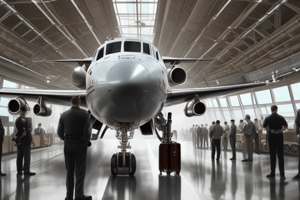Podcast
Questions and Answers
What is the primary goal of Annex 17 in relation to aviation security?
What is the primary goal of Annex 17 in relation to aviation security?
- To eliminate all unlawful interference completely.
- To promote the use of technology in airport operations.
- To ensure the profitability of aviation businesses.
- To establish a framework for effective security controls. (correct)
Which of the following is NOT a consideration in conducting a security risk assessment?
Which of the following is NOT a consideration in conducting a security risk assessment?
- Physical security
- Human factors
- Information technology security
- Passenger satisfaction levels (correct)
What type of security measure includes screening procedures for passengers and baggage?
What type of security measure includes screening procedures for passengers and baggage?
- Emergency response measures
- Threat assessment procedures
- Physical security measures (correct)
- Personnel security measures
What core component does personnel security include to ensure access to secure areas?
What core component does personnel security include to ensure access to secure areas?
What is a key aspect emphasized in security training programs for aviation personnel?
What is a key aspect emphasized in security training programs for aviation personnel?
Which of these measures is crucial for timely response to security threats at airports?
Which of these measures is crucial for timely response to security threats at airports?
How often should personnel security measures be reviewed and updated?
How often should personnel security measures be reviewed and updated?
Which aspect of security does a systematic security risk assessment focus on?
Which aspect of security does a systematic security risk assessment focus on?
Study Notes
Aviation Security Regulations
- Annex 17 is a key component of the International Civil Aviation Organization (ICAO) standards focused on aviation security.
- Establishes requirements for member states to implement effective security controls.
- Aims to protect civil aviation against acts of unlawful interference.
- Emphasizes the need for a security framework that includes regulations, procedures, and responsibilities.
Security Risk Assessment
- A systematic process to identify, evaluate, and mitigate security risks in aviation.
- Involves analyzing potential threats and vulnerabilities to aviation operations.
- Considerations include physical security, information technology security, and human factors.
- Helps to prioritize security measures based on assessed risk levels.
Airport Security Measures
- Physical security measures: fencing, surveillance systems, access control points.
- Screening procedures for passengers, baggage, and cargo.
- Security protocols for aircraft and airport facilities.
- Coordination with law enforcement and emergency services to ensure rapid response.
Personnel Security
- Ensures that individuals with access to secure areas undergo background checks and vetting.
- Includes training and awareness programs to promote a culture of security among staff.
- Regular reviews and updates to personnel security measures based on evolving threats.
- Access control measures to limit entry to authorized personnel only.
Security Training Programs
- Comprehensive training for airport and airline personnel on security protocols and procedures.
- Emphasizes the importance of vigilance and reporting suspicious activities.
- Covers emergency response procedures and crisis management.
- Regular updates and refresher courses to adapt to new threats and regulations.
Aviation Security Regulations
- Annex 17 is a crucial element of ICAO's aviation security framework, mandating adherence to international security standards.
- Member states are required to implement robust security controls to safeguard civil aviation.
- The primary objective is to thwart unlawful interference and threats against civil aviation.
- A comprehensive security framework is necessary, encompassing regulations, established procedures, and delineated responsibilities.
Security Risk Assessment
- A methodical approach to identify, assess, and reduce security risks within the aviation sector.
- It involves evaluating potential threats and vulnerabilities that could impact aviation operations.
- Factors include physical security measures, the security of information technology systems, and human behavior considerations.
- This process assists in prioritizing security initiatives based on the level of identified risk.
Airport Security Measures
- Implementing physical protection strategies such as fencing, surveillance cameras, and controlled access points.
- Conducting thorough screening procedures for passengers, baggage, and cargo to ensure safety.
- Establishing security protocols tailored to aircraft and airport facilities to enhance overall security.
- Collaborating with law enforcement and emergency services facilitates a quick response capability to incidents.
Personnel Security
- Individuals granted access to secure areas must undergo rigorous background checks and vetting processes.
- Initiatives include training programs aimed at fostering a heightened security culture among staff members.
- Regular evaluations and updates to personnel security practices ensure adaptation to new and evolving threats.
- Access control systems are in place to restrict entry, ensuring only authorized personnel can access sensitive areas.
Security Training Programs
- Extensive training sessions are provided for airport and airline staff on essential security protocols and procedures.
- The training emphasizes maintaining vigilance and the importance of reporting any suspicious behavior.
- Emergency response strategies and crisis management techniques are integral components of the training curriculum.
- Continuous updates and refresher courses are essential to keep personnel informed of emerging threats and regulatory changes.
Studying That Suits You
Use AI to generate personalized quizzes and flashcards to suit your learning preferences.
Description
This quiz covers key aspects of aviation security regulations, focusing on Annex 17 of the ICAO standards. Participants will explore systematic processes for security risk assessment and various airport security measures. Understand how regulations protect civil aviation against unlawful interference.




